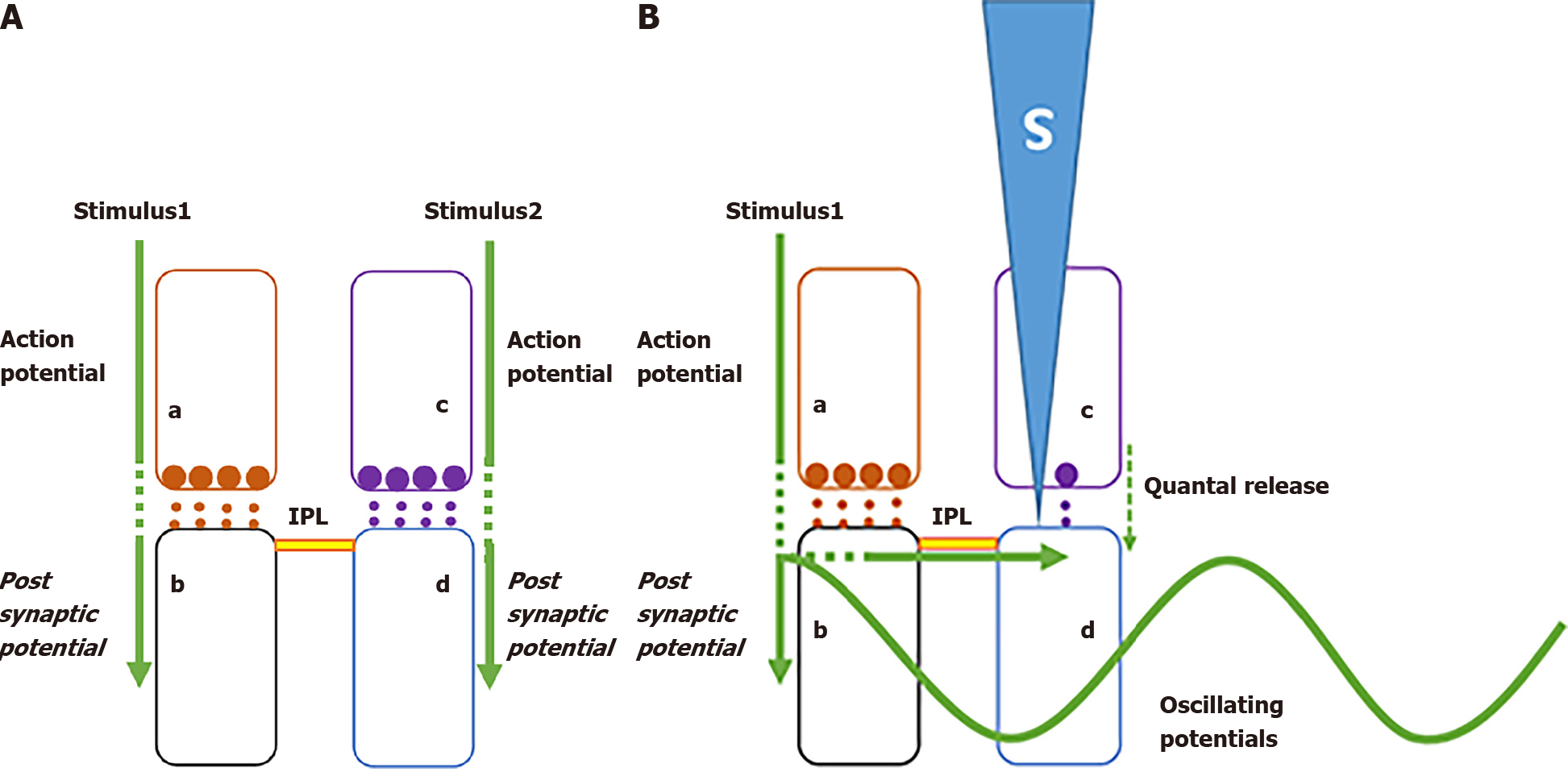Copyright
©The Author(s) 2021.
World J Psychiatr. Oct 19, 2021; 11(10): 681-695
Published online Oct 19, 2021. doi: 10.5498/wjp.v11.i10.681
Published online Oct 19, 2021. doi: 10.5498/wjp.v11.i10.681
Figure 1 Generation of internal sensation of memory which is used as a reference mechanism to examine internal sensation of pleasure.
A: During associative learning between stimulus 1 and 2, signals from these stimuli propagate towards converging locations where inter-postsynaptic functional LINKs (IPLs) between postsynaptic terminals (spines) b and d occur. Spines b and d are depolarized intermittently when action potentials arrive at their presynaptic terminals a and c respectively, and the head regions of these spines are continuously being depolarized by quantally-released neurotransmitter molecules from their presynaptic terminals. These provide a dominant state that a spine is depolarized by its presynaptic terminal that in turn receive signals from stimuli from the environment and is a necessary background condition for generating internal sensation of memory; B: In the above mentioned background state, arrival of stimulus 1 reactivates IPL b-d to cause an incidental lateral activation of postsynaptic terminal d to spark a cellular hallucination (shown using a blue triangle marked S inside) of a sensory stimulus arriving from the environment through its presynaptic terminal c. Details of the method by which sensory qualia of semblions can be determined was described previously[3]. This matches with the expectation of a mechanism for memory[10]. Waveform: Synaptic transmission through synapse a and b and propagation of depolarization through IPL b-d contribute vector components of oscillating extracellular potentials whose frequency needs to be maintained in a narrow range for inducing internal sensation of memory. Specific electrophysiological findings in locations where sensory stimuli converge were found to correlate with behavioural motor actions indicative of specific brain functions. Long-term potentiation (LTP) that can be induced at locations where sensory stimuli converge is an example[87,88]. After application of a high-energy stimulus at a region rich in synapses and following a delay of at least 20 to 30 s[89,90], application of a regular stimulus at the same location generates a potentiated effect when recorded from the postsynaptic dendritic region or postsynaptic neuronal soma. Ability to induce LTP has shown several correlations with animals’ ability to learn. It was possible to explain how learning-induced formation of IPLs is artificially produced in a delayed scaled-up manner during experimental LTP induction[11]. By keeping correlation between the ability to generate internal sensation of memory that matches with sensory features of the item whose memory is retrieved and the ability to induce LTP at specific locations[11], specific electrophysiological changes that can be induced at these locations can be examined to arrive at a mechanistic explanation for internal sensation of pleasure. Since there are specific electrophysiological changes that can be induced at locations responsible for different brain functions, a comparative examination can be carried out to understand how different internal sensations are generated (modified from[3]).
- Citation: Vadakkan KI. Framework for internal sensation of pleasure using constraints from disparate findings in nucleus accumbens. World J Psychiatr 2021; 11(10): 681-695
- URL: https://www.wjgnet.com/2220-3206/full/v11/i10/681.htm
- DOI: https://dx.doi.org/10.5498/wjp.v11.i10.681









